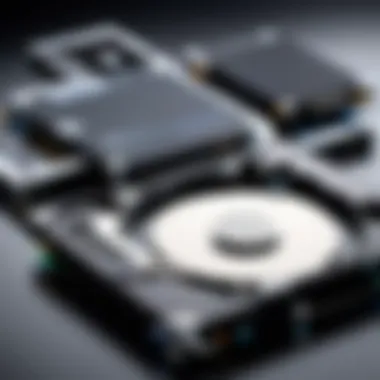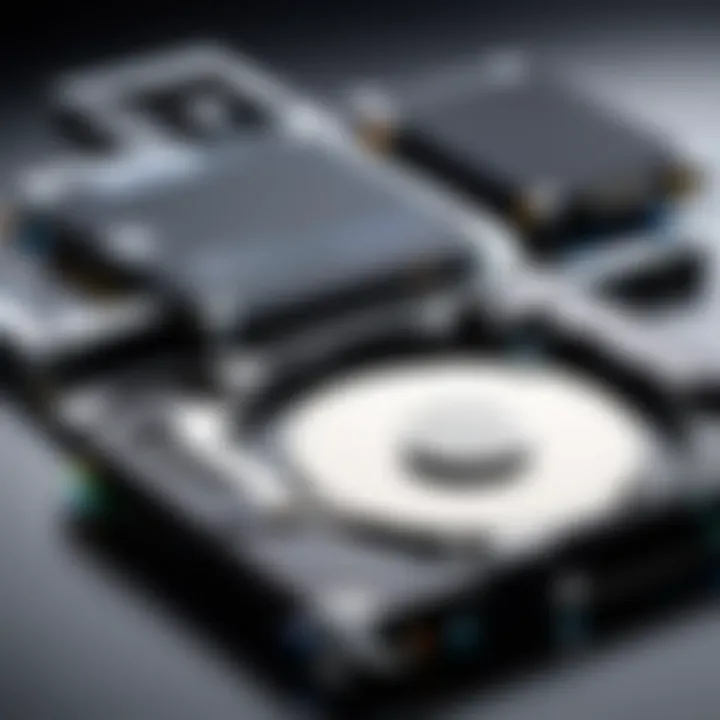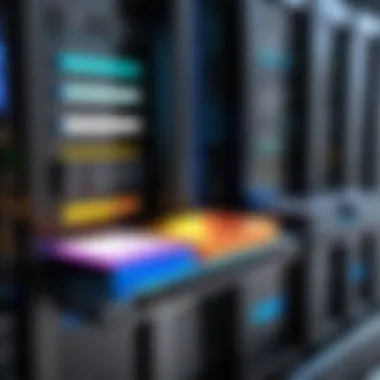Comprehensive Insights into 2TB Hard Discs Solutions


Intro
The presence of digital data has shaped our computing experience. As a result, understanding storage solutions is vital. Among various options, 2 terabyte hard discs are particularly noteworthy. They offer a balance between capacity and affordability, making them suitable for diverse users, from gamers to IT professionals. This article aims to dissect 2 terabyte hard discs, providing insights into their specifications, performance metrics, and relevant applications.
With the volume of data generated daily increasing, knowing about storage devices becomes important. This understanding helps consumers make informed choices that align with their specific needs. The following sections will detail significant aspects associated with these storage solutions.
Product Overview
When discussing 2 terabyte hard discs, several key brands emerge. Companies such as Western Digital, Seagate, and Toshiba dominate the market. Each brand offers unique products tailored to different uses. Below are some essential specifications for these popular models:
- Brand information:
- Key specifications:
- Pricing:
Pricing for 2 terabyte hard discs varies depending on the brand and features. Generally, you can expect to pay between $60 and $100, making them accessible options for many users.
- Western Digital My Passport
- Seagate Expansion
- Toshiba Canvio Basics
- Capacity: 2TB
- Interface: USB 3.0
- Form Factor: Portable
- Rotation Speed: 5400 RPM (common)
Performance Comparison
Comparing these devices requires benchmarks to evaluate their efficiency. Performance often depends on read and write speeds, which are crucial metrics. Data from benchmark tests indicate the following:
- Western Digital My Passport: Average read speed of 130 MB/s
- Seagate Expansion: Close performance with 125 MB/s
- Toshiba Canvio Basics: Slightly lower at 110 MB/s
Each hard drive showcases commendable speeds. Beyond this, efficiency is vital. As tasks demand, these discs maintain stable performance across various file types and sizes. Depending on the user's needs, the differences in performance may not be significantly noticeable during routine tasks.
Features and Technology
Each brand employs unique technologies in their devices.
For instance:
- Western Digital incorporates backup software in their My Passport drives, allowing users to schedule backups conveniently.
- Seagate emphasizes ease of use with their plug-and-play functionality.
- Toshiba offers a sleek design, enabling portability without compromising durability.
Compatibility is crucial. Most 2 terabyte hard discs connect via USB 3.0, promoting widespread use across various systems. Their versatility allows seamless integration with laptops, desktops, and gaming consoles.
Pros and Cons
As with any technology, understanding the advantages and drawbacks is essential:
Strengths of the product:
- Sufficient storage for most users, accommodating games, media, and documents.
- Relatively low cost per terabyte versus larger options.
- Portable and straightforward to use.
Areas for improvement:
- Slower speeds compared to SSDs, which can affect performance for high-demand applications.
- Vulnerability to physical shocks if mishandled.
Value for Money
Evaluating whether a 2 terabyte hard drive delivers good value involves various factors:
- Cost-effectiveness:
At a price between $60 and $100, the cost per terabyte is reasonable. Users gain ample storage without major investment. - Long-term benefits:
This storage capacity helps users manage their data needs as requirements evolve over time. Regularly updating files and content becomes easier. - Comparison with similar products:
Compared to higher-capacity drives, 2 terabyte solutions often offer better price points, making them a practical choice for most users.
Through this exploration of 2 terabyte hard discs, it becomes clear that these devices hold significant value for a range of users. Understanding their specifications, performance, and features helps in making informed decisions to meet individual requirements. The importance of assessing one's needs remains paramount in navigating the landscape of storage solutions.
Preface to Hard Discs
Understanding hard discs is fundamental for anyone engaging with modern computing. They serve as the backbone of data storage, allowing both individuals and organizations to manage and retain information efficiently. In this article, we dive into two-terabyte hard discs, exploring their technical specifications, performance metrics, and various applications. This investigation is crucial as the needs for data storage keep expanding.
Definition and Functionality
A hard disc, commonly known as a hard drive, is a data storage device that uses magnetic storage to store and retrieve digital information. It consists of one or more rigid rapidly rotating discs coated with magnetic material. A read/write head accesses the data while the discs spin, allowing users to read or modify files quickly. The functionality of hard discs is not just limited to storage; they also ensure that data is retrieved and written in a manner that minimizes latency and maximizes efficiency. The capacity, such as the two terabytes we will focus on, directly influences performance and usability in various contexts.
The Evolution of Hard Disc Technology
Since their inception in the 1950s, hard discs have undergone significant transformations. Originally bulky and costly, modern hard disc drives have become smaller, cheaper, and much more efficient. Early technologies employed larger platters and lower data density, which limited storage capacity to mere kilobytes. Over the decades, advancements in technology have achieved remarkable increases in storage density, allowing for massive storage solutions like the two-terabyte options available today. This evolution is crucial for understanding the capabilities and limitations of current storage systems. Each technological leap—from the introduction of the first hard drive by IBM to the current SATA and SSD technologies—has paved the way for enhancements in speed, reliability, and performance.
"While hard discs are often overshadowed by newer technologies, their continued relevance is supported by their durability and cost-effectiveness for high-capacity storage needs."
In summary, understanding the foundation and progression of hard disc technology sets the stage for a deeper discussion on specific capacities like two terabytes, and how they fit into both individual and organizational data needs.


Understanding Terabyte Hard Discs
2 terabyte hard discs have gained popularity due to their balance of capacity, performance, and cost. As digital storage needs grow, understanding these discs becomes crucial for consumers and professionals alike. The flexibility offered by 2TB solutions makes them suitable for diverse applications, from gaming to professional data management. Their capability to store significant amounts of data without a substantial financial investment sets them apart in the storage market.
Capacity and Its Importance
The primary feature of a 2TB hard disc is its capacity.
A 2TB drive can hold approximately:
- 500,000 photos (assuming 4MB per photo)
- 250,000 songs (at 8MB per song)
- 2000 movies (at 1GB per movie)
This massive storage allows users to consolidate their data efficiently. For gamers, it means a larger library of games can fit comfortably on one disc. For professionals involved in video editing or graphic design, the additional space eases the management of projects and raw files. Moreover, having this capacity lowers the frequency of backing up data onto other devices, thus enhancing data accessibility.
The ability to store substantial data is not just about volume; it affects performance. Larger drives tend to experience less fragmentation, reducing slowdowns when accessing files. Thus, capacity is intertwined with performance, making 2TB an attractive option for various users.
Comparative Analysis of Storage Options
When discussing storage options, 2TB hard discs can be compared against other formats like solid-state drives (SSDs) and lower-capacity hard drives.
- HDDs vs. SSDs: Hard Disk Drives (HDDs) provide more storage for less money compared to SSDs. However, SSDs offer faster data access and transfer speeds, crucial for applications like gaming and video editing where delays can affect performance.
- External vs. Internal Discs: An external 2TB hard disc provides portability and convenience, allowing users to easily move data between systems. In contrast, internal drives are typically faster and more reliable, being directly connected to the motherboard.
In addition, when comparing 2TB to higher capacities, such as 4TB or 8TB, the initial cost increases. For many users, the price-to-capacity ratio makes 2TB an economically sensible solution. Overall, the choice largely depends on the specific needs of the user, such as budget, performance requirements, and use cases.
"Understanding the storage landscape enables users to make informed decisions while selecting the right devices for their needs."
In summary, 2 terabyte hard discs offer a practical balance between capacity, performance, and cost, making them a viable choice across various applications. Users should closely consider how individual requirements intersect with the features of different storage technologies.
Technical Specifications of 2TB Hard Discs
Understanding the technical specifications of 2TB hard discs is essential for users who aim to make informed decisions about their storage solutions. These specifications encompass various factors that significantly influence the performance and functionality of the discs. Key elements include data transfer rates, cache size, and form factor. When thoroughly understood, these aspects aid in optimizing system performance and ensuring compatibility with existing hardware.
Data Transfer Rates
Data transfer rate is a critical specification for any storage device. It refers to the speed at which data can be read from or written to the hard disc. For 2TB hard discs, this metric typically varies depending on the technology used—such as SATA or SAS interfaces.
A higher transfer rate often translates to quicker load times, which is especially relevant for gamers and professionals dealing with large files. For instance, hard disc drives, mostly utilizing the SATA III interface, generally exhibit transfer rates around 600 MB/s. In contrast, solid-state drives can reach significantly higher rates, often exceeding 5000 MB/s.
Understanding the specific transfer rate of the chosen hard disc is crucial for maximizing performance and avoiding bottlenecks when performing data-intensive tasks.
Cache Size and Its Impact
The cache size of a 2TB hard disc plays a pivotal role in its overall efficiency. The cache acts as a temporary storage area that holds frequently accessed data for quick retrieval. This allows the hard disc to minimize latency and enhance its responsiveness during read and write operations.
Commonly, 2TB hard discs may have cache sizes ranging from 16MB to 256MB. A larger cache can contribute to improved performance during heavy workloads, such as video editing or gaming. However, it is important to balance cache size with the overall read/write speeds. Sometimes, a high cache size may not fully compensate for slower transfer rates.
Form Factor and Compatibility
Form factor indicates the physical size and shape of the hard disc, which directly impacts its compatibility with various devices. Most 2TB hard discs fall within common form factors, including the 2.5-inch and 3.5-inch versions. The former is often utilized in laptops and portable external drives, while the latter is more common in desktop environments due to its larger size and capacity to dissipate heat.
Ensuring the compatibility of the form factor with your device is critical for seamless installation. For instance, a 3.5-inch hard disc cannot fit into a laptop designed for a 2.5-inch disc without appropriate adapters.
Choosing the right form factor is vital to achieving optimal performance and ensuring that the hard disc fits your hardware requirements.
Performance Metrics
Understanding performance metrics is crucial when evaluating 2TB hard discs. Performance metrics help in gauging how well a hard disc will perform under various conditions. These metrics provide insights into the efficiency, speed, and reliability of the storage device. Knowing these metrics helps consumers, IT professionals, and gamers make informed choices, ensuring that they select the right hard disc for their needs.
Read and Write Speeds
Read and write speeds are perhaps the most immediately noticeable factors impacting a hard disc's performance. These speeds determine how quickly data can be retrieved and stored. A higher read speed results in faster file access times, which is essential when dealing with large files or operating systems that require quick boot times. For example, a 2TB hard disc with a read speed of 160 MB/s will load applications more quickly than one clocked at 120 MB/s.
The importance of write speed cannot be overlooked. It affects how fast data can be saved to the disc. For users who regularly work with big files, such as video editors or graphic designers, speeds of 140 MB/s or more may be necessary for optimal productivity.
"Fast read and write speeds can dramatically alter the user experience, particularly when multitasking or managing large files."
Reliability and Longevity


Reliability and longevity refer to the ability of a hard disc to function consistently over time without failure. Reliability is often quantified by the mean time between failures (MTBF), which measures the average operational period before a failure occurs. A high MTBF indicates greater reliability, making the hard disc a safer choice for storing vital information.
Longevity is equally important; it relates to how long a hard disc will continue to perform well before the performance degrades. Factors that contribute to both reliability and longevity include the quality of materials used in manufacturing, thermal management, and even the usage patterns.
Selecting a hard disc with good reliability and longevity ratings is imperative for consumers who cannot afford downtime or data loss. Regularly monitoring the health of a hard disc through tools like SMART can also help ensure it continues to function properly for an extended period.
Types of Terabyte Hard Discs
The variety of 2 terabyte hard discs available today is crucial for meeting diverse storage needs. Selecting the right type influences not only performance but also the overall user experience. Understanding these types helps consumers and professionals make informed choices based on their specific requirements.
HDD vs. SSD
Hard Disk Drives (HDDs) and Solid State Drives (SSDs) represent two core categories of 2 terabyte hard discs. Their fundamental differences impact storage performance, durability, and cost.
HDDs use spinning disks and read/write heads to access data. They typically offer larger storage capacities for lower cost per gigabyte compared to SSDs. This makes HDDs suitable for users with extensive data storage requirements, like media libraries. However, their mechanical parts mean slower access times and higher susceptibility to physical damage.
On the other hand, SSDs utilize flash memory to store data, resulting in significantly faster data transfer speeds. These drives are better suited for performance-centric tasks such as gaming and video editing. They consume less power, operate silently, and are more durable than HDDs due to the absence of moving parts.
External vs. Internal Discs
When considering 2 terabyte hard discs, the decision between external and internal models warrants careful thought. External hard discs offer convenience and portability, while internal drives provide a more integrated solution.
External discs plug into a computer via USB or other interfaces. This makes them a great solution for users needing to transfer files between devices. They are straightforward to set up, typically requiring no special tools. However, they are vulnerable to environmental factors like moisture and can be physically lost or damaged.
Internal hard discs are installed within a computer case, thus are less prone to damage. They generally offer better performance due to direct connectivity with the motherboard. While installation may be complex and require technical knowledge, internal discs usually deliver superior speeds and reliability for constant use.
Ultimately, the decision should be based on how the user plans to utilize the storage. Frequent travelers might favor external drives, while those seeking reliable, high-speed storage for their system might opt for internal solutions.
"Choosing the right type of hard disc can significantly affect the efficiency and effectiveness of data storage and retrieval."
Taking into account the type of hard disc needed allows users to optimize their computing experience. Understanding the differences between HDDs, SSDs, external, and internal drives can steer consumers toward wiser investments.
Use Cases for 2TB Hard Discs
Understanding the various use cases for 2TB hard discs is crucial for consumers and professionals alike. This segment explores the practical applications of these storage solutions, illustrating their relevance in different contexts. The 2TB hard disc strikes a balance between capacity, performance, and cost, making it a popular choice across diverse fields. In this section, we will discuss gaming and entertainment, professional applications, and general storage solutions.
Gaming and Entertainment
Gaming and entertainment represent one of the primary realms where 2TB hard discs excel. Modern video games can demand substantial storage space due to high-resolution graphics, in-depth narratives, and additional downloadable content. A 2TB hard disc provides ample room for multiple large games, allowing gamers to keep their favorite titles readily accessible without the need to frequently uninstall and reinstall.
Also, streaming services and content libraries have increased significantly. Users can save movies, series, and music collections without worrying about storage scarcity. This storage capacity is particularly useful for those who opt for digital downloads rather than physical copies.
Key advantages of using a 2TB hard disc in this sector include:
- Massive Storage: Ability to house numerous games and multimedia files.
- Enhanced Load Times: Some games benefit from faster access to content, potentially improving performance.
- Versatile Use: Suitable not only for gaming but also for video editing and handling large media files.
Professional Applications
In a professional environment, the demands for data storage can vary greatly, depending on the field. Many professionals, especially in creative industries like video production, graphic design, and software development, often deal with large files and complex projects.
A 2TB hard disc proves invaluable in these situations, offering robust storage solutions for:
- Project Files: Storing detailed assets, including high-resolution images, audio files, and video footage.
- Backup Storage: As a reliable backup for critical data to prevent loss.
- Collaboration: Allowing simple file sharing among team members by keeping all necessary files in one centralized location.
The use of a 2TB hard disc aids in increasing productivity. Professionals can enjoy easier file management and access, leading to smoother workflows.
General Storage Solutions
The versatility of a 2TB hard disc also caters well to general storage needs. Many users require considerable storage space for personal media, documents, and software installations. This hard disc size serves a broad audience by offering:
- File Organization: Its capacity allows users to store essential documents, photos, and videos in an organized manner.
- Local Data Security: Individuals can safeguard their information by avoiding reliance on cloud storage, which can be vulnerable to outages or data loss.
- Cost-efficiency: In comparison to larger storage solutions, 2TB discs often provide the best value for everyday users who need substantial space without the exorbitant costs.
In summary, the use cases for 2TB hard discs demonstrate their adaptability and significance across various sectors. From gaming to professional applications and general storage solutions, they provide valuable benefits that cater to a wide range of users. Their solid performance and capacity make them a smart choice for those seeking effective data management.
Installation and Setup Considerations
The installation and setup of a 2 terabyte hard disc are critical steps that can significantly affect its performance and usability. Understanding these considerations helps users optimize their storage solutions. Proper installation not only ensures that the hard disc operates efficiently but also prolongs its lifespan. Additionally, being aware of specific requirements can save time and prevent potential issues down the line.
Hardware Requirements
Before installing a 2TB hard disc, it is important to assess your hardware. Several key components must be checked to ensure compatibility:
- Motherboard Support: Ensure that your motherboard has the appropriate interface, such as SATA for HDDs or M.2 for SSDs. Checking the version of SATA can also help, as SATA 3 provides better speed compared to older versions.
- Power Supply: Confirm that the power supply unit (PSU) has adequate power connectors for the hard disc. For example, traditional HDDs usually require a 15-pin SATA power connector.
- Physical Space: Make sure that there is enough physical space inside the computer case to accommodate the hard disc. Measure the dimensions and check if there are empty drive bays available.
- Cooling: Consider the cooling requirements. High-capacity discs may generate heat, so sufficient airflow or additional cooling mechanisms may be necessary.
- Interface Compatibility: If using an external disc, confirm that the method of connection (USB, Thunderbolt) is supported by your device.


Checking these requirements helps mitigate issues that may arise during installation, ensuring a much smoother process.
Compatible Operating Systems
Compatibility with operating systems is another crucial element when setting up a 2TB hard disc. Different operating systems have various capabilities for recognizing and utilizing large volumes of storage. Here are some common operating systems and their considerations:
- Windows: Windows 10 and later versions support 2TB hard discs without any special configurations. Ensure that the disc is formatted with NTFS for optimal performance. Windows also provides tools for partitioning, allowing users to effectively manage disk space.
- macOS: macOS supports larger drives as well. The format can be APFS or HFS+. However, there may be limitations on booting from certain external drives, depending on the model year.
- Linux: Most modern Linux distributions recognize and interact with 2TB hard discs seamlessly. Users may need to use tools like GParted for formatting and partitioning.
For any operating system, it is important to ensure that the system is updated. Older versions may not fully support large-capacity drives, leading to issues like unrecognized disks.
Taking the time to understand these installation and setup considerations will enhance your experience with 2TB hard discs, improving both performance and longevity.
Comparative Reviews of Popular 2TB Hard Discs
Importance of Comparative Reviews
In the ever-evolving landscape of data storage, reviewing various 2TB hard discs is vital. This section draws attention to the diverse options available in the market, allowing consumers to make informed choices.
When considering a hard disc, performance, reliability, and cost become essential aspects. Comparative reviews highlight these elements systematically. They serve not just for basic assessment but also demystify technical jargon that often clouds consumers' understanding.
Moreover, these reviews provide insights into how certain models stand against one another, clarifying whether a higher price tag translates into better performance or if a budget option can meet your needs effectively. Overall, understanding the comparative performance of these discs enhances decision-making.
Leading Brands and Models
The market for 2TB hard discs features several prominent brands. Each brand has its unique offerings and specialties. Here are a few noteworthy models:
- Seagate Barracuda 2TB: Known for reliability and speed. It offers impressive data transfer rates and a decent cache size, making it a preferred choice for gamers and professionals alike.
- Western Digital Blue 2TB: This drive focuses on affordability while maintaining strong performance metrics. It is favored among general users seeking cost-effective solutions.
- Toshiba X300 2TB: With a robust build and excellent data management features, the X300 targets demanding users, especially in gaming and creative industries.
- Samsung 870 EVO 2TB SSD: While on the SSD side, this model provides rapid data access and a longer lifespan than traditional HDDs. It is ideal for those who prioritize performance.
Each of these models offers distinctive qualities, catering to a range of user needs, from everyday storage to professional applications.
User Feedback and Ratings
User reviews and ratings serve as invaluable resources for potential buyers. They reflect real-world experiences that technical specifications may not convey entirely.
- Seagate Barracuda 2TB: Users often praise its fast data speeds and overall durability. However, some feedback highlights noise levels during heavy use.
- Western Digital Blue 2TB: This model garners positive reviews for its quiet operation and reliability. Users appreciate the balance between price and performance.
- Toshiba X300 2TB: Many professionals recommend this disc for its performance under load, particularly in gaming and content-created environments. Some note that it gets warmer than competitors when under heavy usage.
- Samsung 870 EVO 2TB SSD: Users revel in its speed and efficiency. Feedback indicates it often exceeds expectations in performance benchmarks, making it tight contender for those who require fast access times.
Overall, user experiences provide a clear perspective on strengths and weaknesses across various models. Researching real-world feedback is essential for optimizing the selection process, ensuring the chosen hard disc aligns with one's specific needs.
Future of Hard Disc Technology
The domain of hard disc technology is on the brink of significant evolution. As digital data continues to grow exponentially, the need for efficient and high-capacity storage solutions becomes increasingly urgent. In this context, understanding the future of hard disc technology is essential. Here, we explore various emerging trends and potential innovations related to two terabyte solutions.
Emerging Trends
The landscape of hard discs is witnessing a variety of emerging trends that are shaping how data is stored and managed. Notable trends include:
- Increased Demand for Capacity: Users require higher storage capacities to accommodate the growing volumes of data generated by applications, gaming, and multimedia content.
- Hybrid Solutions: The convergence of HDD and SSD technologies is taking center stage. Hybrid drives, which combine the best attributes of both, are becoming more prevalent, balancing speed with storage capacity effectively.
- IoT and Big Data Integration: The Internet of Things (IoT) and big data analytics are driving innovations. These technologies require storage solutions that can seamlessly accommodate and analyze massive streams of data.
- Sustainability Initiatives: With an increasing focus on environmental sustainability, manufacturers are working to produce energy-efficient hard drives. This movement minimizes energy consumption and reduces the ecological impact of operating large data centers.
Adherence to these trends is crucial for consumers and professionals in selecting the appropriate storage solutions that align with future needs.
Potential Innovations in Data Storage
Looking ahead, several potential innovations could redefine the capabilities of hard discs:
- Magnetoresistive RAM: This technology promises faster speeds while maintaining the data integrity of traditional hard drives. If implemented effectively, it could offer lightning-fast access times for data retrieval without sacrificing storage capacity.
- Heat-Assisted Magnetic Recording (HAMR): This technique enhances data density on magnetic discs by using heat to facilitate the writing process. As a result, hard drives could achieve significant increases in capacity and performance yet again.
- Artificial Intelligence Integration: The incorporation of AI in storage solutions could lead to more intelligent data management. Systems could autonomously allocate storage resources and optimize read/write operations, improving overall efficiency.
- 3D NAND Technology: This process stacks NAND cells vertically, effectively increasing storage density without expanding the footprint of the drive. The application of 3D NAND in larger capacity hard discs could revolutionize both the speed and efficiency of data storage.
"The future of hard disc technology will likely hinge on advancements that enhance speed and capacity while prioritizing sustainability."
As advancements occur, the storage landscape will evolve, responding to the burgeoning needs of both consumer and enterprise users. Keeping abreast of these trends and innovations will help him efficiently navigate the ever-changing data ecosystem.
Ending
In the landscape of data storage, the role of 2 terabyte hard discs stands out for both personal and professional needs. Throughout this article, significant aspects of these storage solutions have been discussed, helping to illuminate why they are crucial in today's digital environment.
Summarizing Key Insights
The exploration of 2 terabyte hard discs reveals several key insights. Firstly, their capacity offers a substantial amount of storage, allowing users to keep a vast array of files, applications, and multimedia content conveniently in one place. Performance metrics like read and write speeds have shown to be crucial in evaluating a hard disc's efficiency. The comparative analysis with other storage options underscores that while 2TB HDDs may fall short in speed compared to SSDs, they still provide an essential balance of price and performance for many users. Additionally, understanding technical specifications, such as cache size and form factor, helps users make informed decisions tailored to their specific needs.
"Understanding storage options is necessary for anyone looking to optimize their computing experience."
As we look ahead, the expected innovations in data storage technology could further enhance the functionalities and applications of hard discs, making them even more versatile.
Recommendations for Consumers
For individuals considering a 2 terabyte hard disc, several recommendations are essential. Firstly, assess the specific needs based on usage patterns. Gamers may require high read speeds, while those focused on general storage might prioritize capacity and reliability. Compatibility with existing hardware and software should never be overlooked; checking for interface options like SATA or USB is critical. Moreover, considering brands known for quality, such as Seagate or Western Digital, often yields more reliable products. Lastly, evaluating user experiences through reviews can provide valuable insights into the performance and durability of a hard disc.







